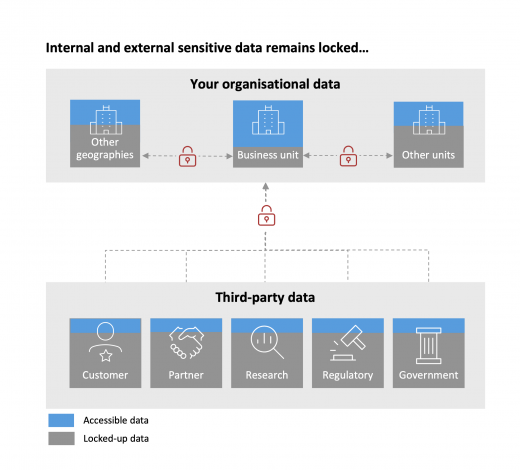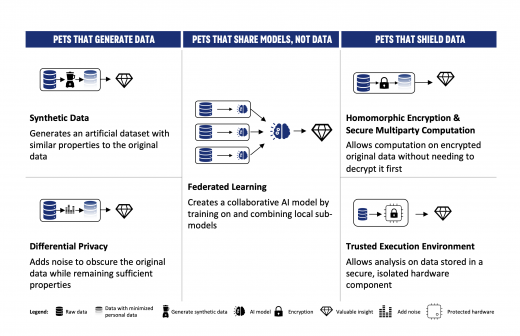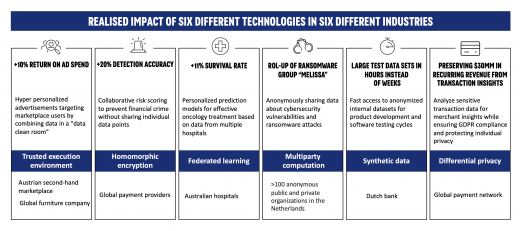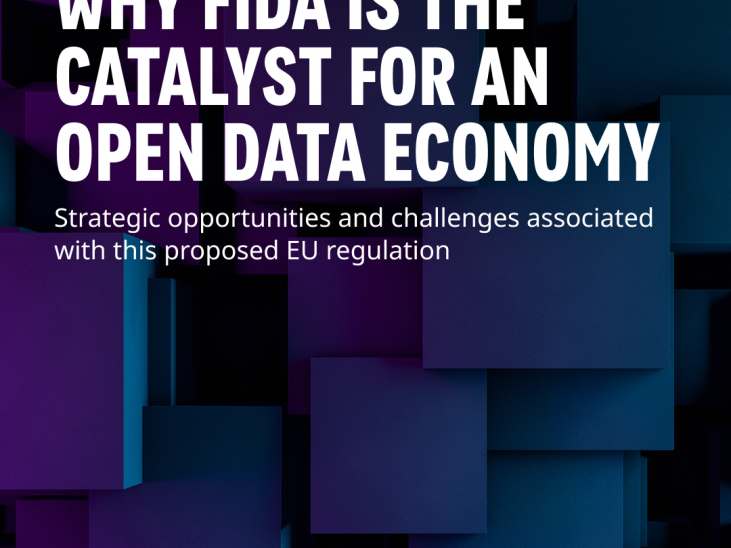Unlocking data potential through Privacy Enhancing Technologies
In today's data-driven world, access to data is an organisation’s most valuable asset. Companies and governments increasingly rely on extensive datasets to support operations, optimise processes and drive innovation. The rise of Artificial Intelligence has strongly amplified this demand.
Despite the abundance of data, accessing the most valuable datasets presents considerable challenges. In the healthcare sector, for instance, organisations must exercise extreme caution when sharing patient data within or across entities due to privacy laws (i.e., GDPR, HIPAA). These legal constraints can significantly impede innovation in areas like personalised medicine and drug discovery, as the necessary data for research and development may remain siloed and inaccessible. In other sectors we see similar barriers to accessing the relevant data.
Exhibit 1 shows a company's data environment. Gaining access to internal data – while seemingly straightforward - can, in practice, still pose substantial hurdles. Especially when dealing with sensitive data across departments, geographies or subsidiaries. Accessing sensitive data controlled by external entities - such as customers, partners, competitors and government organisations - poses even greater challenges.
The challenges associated with data sensitivity can be broadly linked to either business confidentiality or privacy. Disclosing sensitive business data can harm an organisations competitive advantage. Privacy risks pertain to the unwanted exposure of personally identifiable information (PII), ranging from customer profiles to medical records. With organisations, consumers and regulators becoming increasingly data-conscious, both types of data also pose increasing reputational and regulatory risks.
A new paradigm: share insights, not data
Privacy Enhancing Technologies represent a paradigm shift in overcoming barriers and risks mentioned above. This emerging set of technologies allows organisations to move away from the direct sharing of raw data. Focus is on gaining insights by running analytics over combined datasets, while not exposing the individual records containing the actual raw information. These solutions are designed to protect organisations from data breaches and unwanted use of their data, enabling collaboration and analysis without compromising on privacy and commercial confidentiality or creating reputational risks.
Privacy Enhancing Technologies (PETs) is a collective term for a toolbox of data protection techniques. PETs either generate non-sensitive data out of sensitive data, share trained models instead of data, or shield data so that no one can access it, while still allowing operations on it. The five most relevant techniques are mapped below.
Like any toolbox, each technique has its specific use, advantages and drawbacks, and can often be used in combination with others to achieve a tailor-made result.
PETs already provide real-world impact across sectors
By leveraging PETs, organisations can harness data’s full potential within a secure framework, not only to comply with stringent regulatory requirements, but also to build trust among stakeholders, encouraging more open and fruitful data collaborations.
PETs are already creating substantial value across innovators in various data-hungry sectors, including healthcare, finance, mobility, cyber security, and advertising, as showcased by the six examples, in exhibit 3, each applying a different technique.
Numerous innovators have proven the value of PETs in real world use cases. By deriving business insights from collaborative analytics, organisations can ultimately enhance their operational capabilities and innovation potential while avoiding data breach risks.
Currently, we see that the market landscape is maturing. Driven by an upward spiral of technological advancements, increasing demand, proven use cases, and an emerging supplier landscape.
Three actions to take to kickstart your PET journey
We believe the time is now to start integrating PETs into your data and AI strategy and unlock the value potential of internal and external data while limiting risks.
To accelerate your time to impact with PETs, we believe organisations should take the following three actions:
- Foster cross-functional collaboration between IT, legal, compliance and business teams to develop cohesive data sharing strategies that effectively utilize PETs
- Experiment with fast proofs-of-value for PET use-cases, to showcase solutions working in practice as input for further discussion with data sharing stakeholders. Partnering with PET start-ups can accelerate this process.
- Create a “minimal viable ecosystem” of external early adopter organisations to kickstart the first real data collaborations on a small scale. Once these collaborations prove successful, others will likely follow.
Oliver Wyman and INNOPAY have extensive expertise and experience to guide you through all the steps, from creating your data strategy, identifying use cases and rapid prototyping, to the implementation of specific data collaborations. In this way, we can help you achieve breakthrough business impact while limiting your data sharing risks. Please get in touch with Pieter Verhagen to learn more.






